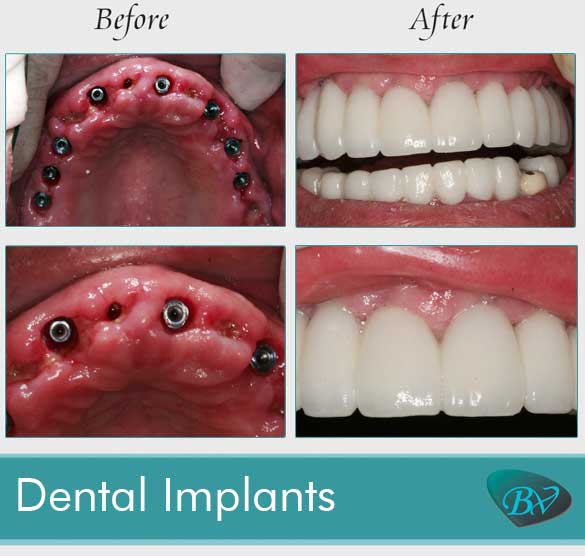Getting The Dental Sense To Work
Getting The Dental Sense To Work
Blog Article
6 Easy Facts About Dental Sense Shown
Table of ContentsNot known Details About Dental Sense About Dental SenseDental Sense for DummiesSome Known Factual Statements About Dental Sense
are clinical tools surgically implanted right into the jaw to recover a person's capability to chew or their look. They provide support for synthetic (phony) teeth, such as crowns, bridges, or dentures. When a tooth is lost as a result of injury or condition, a person can experience problems such as fast bone loss, faulty speech, or changes to chewing patterns that cause pain.Dental implant systems are composed of an oral implant body and dental implant abutment and might likewise consist of an abutment fixation screw. Kids dental. The dental implant body is surgically inserted in the jawbone instead of the tooth's root. The oral implant joint is typically connected to the implant body by the abutment fixation screw and expands via gum tissues right into the mouth to support the connected fabricated teeth
(https://www.merchantcircle.com/dental-sense-miami-fl#tips)Framework of The Oral Implant System choosing oral implants, speak to your oral company regarding the prospective advantages and risks, and whether you are a candidate for the procedure. Points to consider: Your total health and wellness is an important aspect in identifying whether you are a good prospect for oral implants, for how long it will take to recover, and exactly how long the implant may remain in location.
Cigarette smoking may influence the healing process and lower the long-term success of the dental implant. The recovery process for the implant body might take numerous months or longer, throughout which time you generally have a temporary joint in area of the tooth. the oral implant treatment: Thoroughly follow the oral hygiene guidelines offered to you by your oral company.
Some Ideas on Dental Sense You Need To Know
Implant failure can lead to the need for another surgery to fix or change the dental implant system. Restores the ability to chew Recovers cosmetic appearance Aids keep the jawbone from reducing as a result of bone loss Protects the health and wellness of the bordering bone and gum tissues Helps keep adjacent (nearby) teeth stable Enhances high quality of life Damage to bordering all-natural teeth throughout implant positioning Injury to the surrounding cells during surgical treatment, such as sinus perforation Injury throughout surgical procedure (as an example, fracture of bordering jawbone) Insufficient feature, such as seeming like the teeth do see this not attack together normally A sensation that the tooth hangs or turning in position arising from an abutment screw loosening Implant body failing (looseness of the implant body) because of systemic infection, which may be more probable in clients with unrestrained diabetes mellitus due to neighborhood infection in bone and periodontals supporting the implant body due to postponed healing, which may be extra likely in people who smoke Difficulty cleaning up the periodontals around the dental implant, resulting in poor oral hygiene Untreated gum disease Post-surgical feeling numb because of nerve impingement or damages Always inform healthcare suppliers and imaging specialists that you have dental implants before any kind of magnetic vibration imaging (MRI) or x-ray treatments.
FDA is not knowledgeable about any type of damaging events reported for MRI or x-ray treatments with dental implants. Oral implants systems are normally constructed from materials that adhere to international agreement criteria of the International Organization for Standardization (ISO) or ASTM International. These requirements have information of what makes a secure product.

An oral implant is a framework that changes a missing out on tooth. With screw-like devices, the specialist inserts a dental implant into the jawbone, and it acts as an anchor for a synthetic tooth, called a crown.
Dental Sense - Questions
Some individuals are not eligible for oral implant surgery. It is for dental cosmetic surgeons to operate people with: severe illnessuncontrollable metabolic diseasebone or soft cells condition or infectionIf these issues are solved, an individual can have the surgery. In, dental surgeons avoid operating individuals with: If individuals with any one of the above go through oral implant surgery, there is a greater risk of the implant stopping working.

Dental dental implant surgical procedure is an individualized procedure. It's not the same for every person. Yet the complying with provides a basic introduction of what you can anticipate your dental professional, oral cosmetic surgeon, periodontist or prosthodontist to do: Put the dental implant surgically. Give you time to heal. Affix the post and last crown, bridge or denture.
Next off, your specialist will meticulously put the dental implant right into your jaw. If your implant is near the front of your mouth, your dental practitioner will certainly make a temporary tooth for you to use till you heal.
Dental Sense Things To Know Before You Get This
Throughout the healing stage, your jawbone must fuse to the oral implant. This process can take anywhere from three to 9 months.
As soon as your dental implant heals, your dental practitioner can connect the abutment (little connector article) and your last restoration (crown, bridge or denture). This normally takes about one hour to finish and may require a second small surgical procedure. You shouldn't feel any kind of pain during your oral implant treatment since your supplier will use medicine to numb your gum tissues.
Report this page